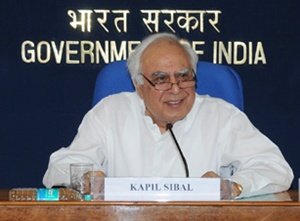Draft policy sees ITeS sector growing $300 billion-strong by 2020
07 Oct 2011
The draft National Policy on Information Technology 2011, released today, envisages an over three-fold increase in revenue from the country's information technology and IT-enabled services from $88 billion at present to $300 billion by 2010.

Releasing the draft policy, minister of communications and information technology Kapil Sibal said information technology is a key driver of an increasingly knowledge-based global economy, and that India is well positioned to enhance and leverage its existing IT capabilities for a leadership role.
Information technology, he said, has transformational power, and it is a great leveler of opportunity within and across economies. With the right policies and investment in infrastructure, he said, India has the opportunity to strengthen and enhance its position as a global IT powerhouse.
On the domestic front, he said, the use of IT across various sectors would help transform the economy, enhance equity and help the nation to rapidly improve its development indices.
The draft National Policy on IT 2011 envisages an increase in revenues of IT and ITES industry to rise to $300 billion by 2010 from $88 billion at present.
The IT industry has been a significant contributor in the economy's over-8 per cent growth achieved in the past decade.
Since, 80 per cent of the $88 billion IT industry revenues in 2010-11 came from exports, the policy proposes to encourage growth of indigenous demand and market to sustain the current growth. The draft policy also aims at formulating fiscal and other incentives to attract investment in this sector in Tier II and Tier III cities.
The Indian IT and ITES sector currently employs over 2.5 million skilled people and has been one of the major employment generators in the last two decades.
The focus of the IT policy is on deployment of ICT in all sectors of the economy and providing IT solutions to the world. The National Policy on IT aims to strengthen and enhance India's position as the global IT hub and to use IT as an engine for rapid, inclusive and sustainable growth in the national economy.
The policy aims to leverage the power of ICT to the maximum to help address the monumental economic and developmental challenges the country faces.
The thrust areas of the policy include:
- Increase revenues of IT and ITES Industry from $88 billion to $300 billion by 2020;
- Formulate fiscal and other policies to attract investment in IT Industry in Tier II and Tier III cities;
- Promote innovation and R&D in cutting edge technologies and development of applications and solutions in areas like localisation, location based services, mobile value added services, cloud computing, social media and utility models;
- Provide fiscal benefits to SMEs and start-ups in the key industrial sectors for adoption of IT in value creation;
- Leverage internet, web and mobile technologies for developing new products, technologies and businesses;
- Integrate internet-based and mobile-based delivery of services onto a common platform to enable seamless, ubiquitous, secure and personalised delivery of government and non-government services throughout the country;
- Integrate Aadhaar, financial and location-based services into this integrated platform to foster an ecosystem for innovation in services.
- Create a pool of 10 million additional skilled manpower in ICT;
- Make at least one individual in every household e-literate;
- Extend the National e-Governance Plan (NeGP) and mandate provision of all government services through electronic mode within a fixed time frame by enactment of the electronic delivery of services (EDS) bill;
- Enhance transparency, accountability, efficiency, reliability and decentralisation in government and in particular, in delivery of public services;
- Leverage ICT for key social sector initiatives like education, health, rural development and financial services to promote equity and quality;
- Make India global hub for development of language technologies to encourage and facilitate development of content accessible in all Indian languages and thereby help bridge the digital divide;
- Enable access of content and ICT applications by differently abled people to foster inclusive development;
- Facilitate adoption of ICTs in key economic and strategic sectors to improve their competitiveness and productivity; and
- Strengthen regulatory and security framework for ensuring a secure cyberspace ecosystem.
The department of information technology has sought comments from the public on the draft policy, which is available on its website.













.jpg)






.jpg)









